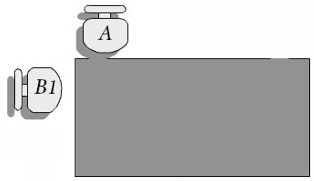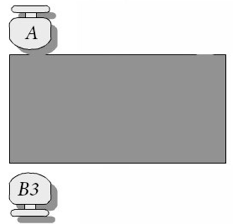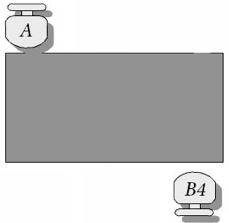Business Negotiations Between American and Vietnamese Businesses: The Influence of Proxemics and Site Setting on Negotiation OutcomesOwn TerritoryNegotiating in one’s own territory is the option that most American people desire as a negotiation site. Chu and colleagues (2005) pointed out that 69% of negotiators believe that the party that designates the negotiation site has an advantage in negotiations, and 71% find it more comfortable to negotiate in their own turf. The hosting party can benefit in their own territory from both internal and external factors. Internally, the host has control over the location and protocol, which leads to less psychological stress, more dominance behaviors, and less likelihood to conform than visitors (Altman, 1975; Mayfield et al., 1998). Externally, the ability to arrange the meeting and adapt to the needs of the other party can help elevate the host’s image and enhance the relationship, thus encouraging the other party to be less pushy and to more easily accept the host’s proposition (Benoliel, 2011). Nevertheless, while the hosting party receives a dual advantage negotiating on their own turf, inviting the other party to their place is not always possible, especially with Vietnamese business people, who mostly prefer meeting at their own place. Other’s TerritoryVietnamese business people usually invite their partners to the office to do negotiations, not only because they realize the aforementioned benefits of being host, but also because this is part of the culture. Vietnamese people usually enjoy showing their hospitality, building relationship, and seeking rapport, even in business. In Vietnam, success in business is based not only on skills, experience, and values, but also on whom one knows. Relationships precede everything. Vietnamese people may not do business with someone they do not know thoroughly (Ashwill & Diep, 2004), which is why doing business in Vietnam is less like an American mindset of a partnership, but more of a friendship.While going to an American company seems too strict, formal and uncomfortable for most Vietnamese, inviting Americans to their own place is a way to welcome the expats, help the parties to get to know each other, and slow down the Western business pace. Even though the environment may be too relaxed for Americans, it is when the Vietnamese people get their first ideas about their potential partners, and those ideas can influence the negotiation outcomes. Coming into another’s territory poses difficulties for many, including Americans. It has been researched that more than half of negotiators feel a greater challenge when negotiating in the other side’s turf (Chu et al, 2005). However, Mayfield and her colleagues (1998) argued that there are certain advantages of being a guest. First of all, the overall hospitality of the host can give the guests warm sentiments and lessen frustration. Moreover, just as the Vietnamese want to know more about the guests, it may be necessary for the Americans to get a firsthand view of the host company’s facilities, personnel and capabilities, to see if they meet expectations and are able to reach the business goals. Lastly, visiting the other’s turf may show the guest’s concern and interest, as the host can save time, money, and work in a more comfortable environment. Physical ArrangementAs the location has an important impact on the quality and outcome for a negotiation, so does the physical arrangement at the site. Benoliel (2011) described such an arrangement in Charlie Chaplin’s movie The Great Dictator. In one scene, Mussolini was invited to see Hitler, and Mussolini was arranged to enter through an end door that was far from Hitler’s desk. Mussolini had to walk through the enormous room, feeling small in this great space. In addition, Mussolini’s chair was specially made so that it was extremely low compared to that of Hitler, making him look up to the latter. Both of the tactics were designed to belittle Mussolini and empower the Führer, giving Hitler an initial advantage for the meeting. Many studies have been done to explore the effect of physical settings on communication and social interaction. Rubin and Brown (1975) noted that the physical arrangement could influence the psychological climate of social interaction, as well as set the degree of formality and tension for the participants. Knapp and Hall (2001) also argued that people both influence and are influenced by the environment. The surroundings have the ability to produce feelings and alter people’s perceptions. Hall (1966) categorized the dimensions of physical arrangement in the environment as (1) fixed-feature space, and (2) semi-fixed-feature space. The first category refers to space organized by established boundaries, such as rooms or closed spaces. The fixed-feature space acts on people’s preferences on spatial zone and distance with others during social interactions. The second category of semi-fixed-feature space refers to the arrangement of tables and chairs. Within the scope of business negotiation, this category refers to the seating arrangement and furniture arrangement at the negotiation site. Both of these categories have a profound impact on communication behaviors (Knapp & Hall, 2001). Space and DistancePeople have certain patterns in deciding their comfortable distance when they interact, and this distance varies according to the person’s background, culture, social norms, and the nature of the social interaction. Moving too close is considered invading a person’s expected zone distance, which can result in extreme discomfort, and negative thoughts and feelings, which will not serve any party’s interests (Hall, 1966). Hall (1966) identified four types of distances, which are intimate, personal, social, and public. Among them, a business negotiation, as with many other business communication processes, would fall into the social zone. The zone measurements are not fixed from country to country, but as mentioned by Hall (1966), are culturally conditioned. Hall grouped countries in which people tend to stand closer, touch more, and exhibit more physically intimate behaviors into high-contact cultures. In contrast, low-contact cultures are those in which people interact more indirectly and enjoy a wider distance between them. America has been found to be a moderate-contact culture, where the distance preference is to a lesser degree, while many Asian countries, especially East Asian countries, are low-contact cultures (Hall, 1976; Ting-Toomey, 2012). For American people, social distance is defined as a bubble of four to 12 feet around the communicators. In its far phase, which happens in communication with people one does not know well, the distance is from seven to 12 feet. Physical barriers, such as tables and other furniture, are used to make people keep this distance. On the other hand, the close phase, which happens in communication with acquaintances, only has the distance of four to seven feet. The interaction in this phase tends to be less formal (Hall, 1966). On the other hand, not many studies were done on Vietnamese people’s social distances. Bui (2009) and Le (2009) each conducted a survey on a small scale, with 30 and 50 Vietnamese respondents respectively, to understand the conversational distance between businesspeople during negotiations. The data from their studies showed that most Vietnamese people enjoy the distance of four to seven feet when meeting business acquaintances. The results held true regardless of the parties’ gender (i.e. if it was a same-sex or cross-sex encounter). Their findings indicated that even though Vietnam is an Asian country, it is a moderate-contact culture, and the distance preference during business negotiations is very similar to that of American people. Seating ArrangementsPease (1981) stated that strategic positioning in relation to other people is an effective way to get cooperation. The default arrangement can have an effect on the position chosen (Knapp & Hall, 1978) while the way that one party chooses to position him or herself can reveal his or her perception and attitude toward the other party (Pease, 1981). In 2005, Chu, Strong, Ma and Greene conducted a survey of nonverbal communication in business negotiations with more than 80 participants from many countries, including Americans whose first language is English. All of the participants had previous negotiation experience. In accordance with previous studies, in Chu and colleague’s survey, 75% of the respondents replied that seating arrangement should get more attention from negotiators, as they deemed it important for a satisfactory negotiation. Several factors were found to have influence on seating arrangements, proximity, bodily orientation and the nature of the relationship (Sommer, 1965). While proximity and bodily orientation are conditioned by the intuitive, aforementioned distance preference, the nature of the relationship is related to one’s perception of other people. Sommer (1965) conducted naturalistic observation and conducted questionnaire study of seating preference. He found that a cooperative relationship or a competitive relationship would make people choose seats differently. Sommer’s research found that in cooperative relationships, side-by-side seating was preferred, while in competitive relationships, face-to-face seating was used with a larger distance between parties. Sommer argued that oppositional seating might induce less conversation and reflect a desire to obtain more information about the other competitive party, rather than a wish to form a friendly relationship. Lewicki and Litterer (1985), in their book Negotiation, also supported Sommer’s findings when concluded that the more competitive the parties were, the greater physical distance from one another. They also stated that competitive parties were more likely to place tables or other furniture as barriers between them to prevent each other from invading their territories. As described by Pease (1981), there are four basic seating positions in an office environment with a standard rectangular desk. In each of the arrangement, A represents the host, or whoever arrives at the site first, and B represents the visiting party, or whoever arrives later. When sitting at other desk shapes (i.e. round or oval desks), the observed distance preferences stay almost proportional to those of rectangular desks (Knapp & Hall, 2011). Therefore, we can generalize the seating positions from the ones described below. Figure 1 shows a corner position seating arrangement. As Pease (1981) stated, communicators choose this arrangement to create a friendly and casual atmosphere, thus increasing the chance of a favorable negotiation. In Knapp and Hall (2001)’s observation of American seating behaviors in a task-oriented situation, this position is the second-most favorite position for conversations, with only 4% behind the opposite (face-to-face) position. Figure 2 shows the cooperative position, which is often known as “siding with the opposition.” Knapp and Hall (2001) observed that this arrangement is the most preferred position for people who work on the same task, when the desire for cooperation elicits a side-by-side choice. Pease (1981) agreed that this position would work two people who are mutually oriented and have similar points of view. The close distance between the two parties makes it easy for them to share information and documents during meeting. It is a strategic arrangement for presenting ideas and having them accepted. Nonetheless, this arrangement may not work if A and B are not already acquaintances, because it causes B to invade A’s territory, and can cause B to develop negative feelings toward A. Figure 3 shows the competitive/defensive position. This position is the one most observed for both conversational and competitive tasks in Knapp and Hall (2001)’s research. It is the dominant choice for competing parties. Pease (1981) explained that sitting across the table creates a defensive, competitive atmosphere because the table acts as the solid barrier between the parties. When sitting in this position, each party subconsciously divides themselves into two equal territories, which makes them stand firmer on their points of view and reduces the chance of a successful negotiation. Furthermore, if this position is not situated at a neutral location, the visiting party may have a significant psychological disadvantage (Pease, 1981; Lewicki & Litterer, 1985). It would make B think that A deliberately took the “power” seat and reserved a distance to sit directly across from them to show A as more superior. Figure 4 shows the independent position. This is the position taken when both parties lack interest in each other and do not wish to interact (Pease, 1981; Knapp & Hall, 2001). It occurs, for example, when two strangers take seats at a table in a library. Naturally, this position should be avoided when an open discussion is needed. Many studies found that a choosing position is not done intuitively, but negotiators actively pick specific seats to show their status to the other party. Knapp and Hall (2001) observed that leaders and dominant personalities were more likely to choose seats to reinforce their status. Anderson (1993) agreed when he stated that leaders tend to take more space, so that they appear to be in charge. Additionally, Johnson (1993) said that negotiators intentionally pick the “power” positions, such as a delegated seat, head of table, or back against a wall to make them feel more confident. The power position is different from the chairperson position, when the role of the chairperson is understood or implied among the meeting participants, and the seat is reserved for that person to facilitate the meeting flow. The power seating position, on the one hand, is taken by an individual who wants to wield personal power. This power seating position was described by Pease (1981) to have the ability to raise status and power through the seat’s size, height and location. He concluded that the higher the back of the chair, the greater the status of the person is perceived. As royal members choose to have a higher back on their chairs, the subjects regard their statuses as higher as well. Another common power play is adjust chair height, with the impact emphasized even more in the competitive position. If the host’s seat is adjusted to have maximum height compared to the visitor’s, the host can put the visitor at a subconscious disadvantage, as mentioned previously in the example of the movie The Great Dictator. The chair power play is an impactful seating arrangement strategy to create a certain atmosphere in the office (Pease, 1981). In addition to the chair positioning, it is also noteworthy that the shape of desk at the negotiation site also has an impact on the negotiation process. Even though a rectangular desk is usually used at meetings, Chu and colleagues (2005) found that a round table actually encourages better meeting facilitation. In this study, 54% of respondents stated that they prefer round tables in negotiations, as 57% believed that the round shape can help ease tensions and 53% deemed that it can make the atmosphere more conducive for discussion. While some research has been conducted on seating arrangements in the United States and many other countries, including Asian countries such as China and Japan, little research has been done on how Vietnamese people make seating arrangements. However, many recommendations, mostly based on feng shui principles, have been made to Vietnamese business people, showing them how to make the best out of a negotiation. A number of companies still practice these feng shui principles. At the early stage of any business advancement, there are usually informal meetings, which Vietnamese people use to get acquainted to their potential partners. At these occasions, small round tables such as that in Figure 5 are often used to reduce the distance and to make everyone seem equal (XZone, 2012). During official meetings in Vietnam where major decisions are to be made, it is suggested that a rectangular desk be used (XZone, 2012), as illustrated in Figures 6a and 6b. Figure 6a shows the seating arrangement where the host party is taking one side of the table, and leaving the other side for the visiting party. The host’s most important member is seated in the middle, with the support of subordinates coming from both sides. All seats in the 6a arrangement are identical, the only distinction being that the hosting party faces the entrance, while the visiting party members have their backs against the entrance. Figure 6b also shows the seating where each party takes one side of the table, but the host’s most important member takes the head-of-table seat. In this case, the host’s seat is advised by many feng shui practitioners to be bigger and higher, with a higher back and armrests, and most preferably facing the entrance and against the wall (Too, 2006).Continued on Next Page » Suggested Reading from Inquiries Journal
Inquiries Journal provides undergraduate and graduate students around the world a platform for the wide dissemination of academic work over a range of core disciplines. Representing the work of students from hundreds of institutions around the globe, Inquiries Journal's large database of academic articles is completely free. Learn more | Blog | Submit Latest in Business & Communications |






















